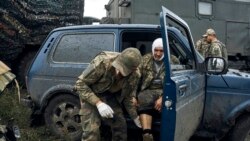ນັບຕັ້ງແຕ່ ປີ 2015, ຄລີນິກປົວຕາຂອງອາເມຣິກາ ທີ່ເກົ່າແກ່ທີ່ສຸດ ແຫ່ງນຶ່ງ ຊື່ວ່າ Wills Eye Hospital, ໄດ້ຊ່ອຍປົວພວກທະຫານຢູເຄຣນ ທີ່ບາດເຈັບສາຫັດຢູ່ຫົວ ຫຼືບາດແຜຢູ່ໃບໜ້າ ນຳເອົາສາຍຕາຂອງພວກເຂົາເຈົ້າກັບຄືນມາໄດ້. ສຳລັບໝໍຜ່າຕັດທ່ານນຶ່ງ ທີ່ມີຮາກເງົ້າຈາກຢູເຄຣນ ວຽກງານນີ້ເປັນເລື້ອງສ່ວນຕົວ. ນັກຂ່າວວີໂອເອ ອີຣີນາ ໂຊລອມໂກ ມີລາຍງານ ເຊິ່ງ ໄຊຈະເລີນສຸກ ຈະນຳລາຍລະອຽດ ມາສະເໜີທ່ານໃນອັນດັບຕໍ່ໄປ.
ພໍ່ແມ່ຂອງ ທ່ານ ຈູຣິຈ ບີລິກ ອາຈານດ້ານສາຍຕາ ແລະໝໍຜ່າຕັດສັນຍະກຳ ແມ່ນມາຈາກປະເທດຢູເຄຣນ, ແຕ່ທ່ານເກີດຢູ່ທີ່ແຫ່ງນີ້ ແລະມີຄວາມຜູກພັນຢ່າງເລິກເຊິ່ງຕໍ່ບ້ານເກີດເມືອງນອນຂອງພໍ່ແມ່ເພິ່ນ.
ທ່ານ ຈູຣິຈ ບີລິກ ໝໍຜ່າຕັດສັນຍະກຳ ກ່າວໃນພາສາຢູເຄຣນ ວ່າ “ປະຊາຄົມຊາວຢູເຄຣນ ຮູ້ຈັກເບີໂທລະສັບຂອງຂ້ອຍ, ອົງການຕ່າງໆໃນທ້ອງຖິ່ນກໍເຊັ່ນກັນ, ແລະພວກເຂົາເຈົ້າ ກໍໂທຫາຂ້ອຍ.”
ພວກເຂົາເຈົ້າໂທຫາທ່ານ ບີລິກ ເພາະວ່າ ເພິ່ນເຮັດວຽກຢູ່ໂຮງໝໍ Wills Eye ໃນນະຄອນ ຟີລາແດລເຟຍ ລັດເພັນຊີລເວເນຍ ເຊິ່ງມີປະຊາກອນຊາວຢູເຄຣນ ແລະເນື່ອງຈາກວ່າ ທ່ານເປັນຜູ້ຢູ່ໃນຖານະທີ່ພິເສດ ເພື່ອຊ່ອຍພວກນັກລົບເກົ່າ ຂອງສົງຄາມໃນຢູເຄຣນ ທີ່ໄດ້ຮັບບາດເຈັບ.
ທ່ານໝໍ ບີລິກ ກ່າວວ່າ “ສິ່ງທີ່ຂ້າພະເຈົ້າຈະກ່າວ ກໍແມ່ນວ່າ ຄະນະບໍລິຫານ ຂອງໂຮງໝໍ ບໍ່ເຄີຍກ່າວວ່າ ບໍ່ຮັບເລີຍ.”
ທ່ານ ບີລິກ ເປັນນັກຊ່ຽວຊານໃນສິ່ງທີ່ເອີ້ນວ່າ ອອກກູໂລແພລສຕິກ ເຊີເຈີຣີ (oculoplastic surgery) ຫຼື ການຜ່າຕັດໃບໜ້າບໍລິເວນອ້ອມຕາ ທີ່ລວມທັງ ໜັງຕາ. ນັບຕັ້ງແຕ່ສົງຄາມໄດ້ເລີ້ມຕົ້ນຂຶ້ນ ໂຮງໝໍດັ່ງກ່າວ ໄດ້ຊ່ອຍປົວພວກ ທະຫານຢູເຄຣນ ທີ່ໄດ້ຮັບບາດເຈັບໜັກຢູ່ໃບໜ້າແລະຕາ.
ທ່ານມາກ ເບລເຊີຣ ເປັນຫົວໜ້າຝ່າຍບໍລິຫານຂອງໂຮງໝໍ. ທ່ານກ່າວວ່າ ພວກເຂົາເຈົ້າໃຫ້ການຊ່ອຍເຫຼືອປະເພດນີ້ ແກ່ຊາວຢູເຄຣນ ທີ່ໄດ້ຮັບບາດເຈັບ ໂດຍບໍ່ເສຍຄ່າໃຊ້ຈ່າຍເລີຍ ກໍຍ້ອນການບໍລິຈາກຂອງຄົນພາຍນອກທັງຫຼາຍ.
ທ່ານເບລເຊີຣ ກ່າວເປັນພາສາອັງກິດວ່າ “ພວກເຮົາມີບັນດາຜູ້ບໍລິຈາກຈຳນວນ ນຶ່ງ ຜູ້ທີ່ເປັນເພື່ອນທີ່ດີຂອງ Wills, ພວກເພິ່ນ ໂດຍພິເສດແລ້ວ ໄດ້ປະກອບສ່ວນເຂົ້າໃນກອງທຶນເພື່ອຊ່ອຍ ແລະຮັບປະກັນວ່າ ພວກເຮົາສາມາດສືບຕໍ່ສະໜອງການຮັກສາເບິ່ງແຍງພວກທະຫານຊາວຢູເຄຣນ ໃນຍາມທີ່ຕ້ອງການ.”
ທ່ານໝໍ ບີລິກ ກ່າວວ່າ ນັບຕັ້ງແຕ່ຣັດເຊຍ ໄດ້ບຸກລຸກຢູເຄຣນ ວັນທີ 20 – 22, ພວກທະຫານຈຳນວນ 20 ຄົນ ໄດ້ເຂົ້າມາທີ່ນີ້ ເພື່ອການຜ່າຕັດຕາ ທີ່ບໍ່ສາມາດເຮັດໄດ້ຢູ່ໃນ ຢູເຄຣນ. ບາງກໍລະນີໃຊ້ເວລາຫຼາຍຊົ່ວໂມງ ແລະ ສ່ວນຫຼາຍແມ່ນພົວພັນກັບການຜ່າຕັດຫຼາຍກວ່ານຶ່ງຄັ້ງ.
ທ່ານໝໍ ບີລິກ ກ່າວເປັນພາສາຢູເຄຣນ ວ່າ “ຂ້າພະເຈົ້າຄຶດວ່າ ການຜ່າຕັດ ທີ່ດົນທີ່ສຸດທີ່ໄດ້ກະທຳ ໂດຍທ່ານໝໍ ຊາຍເຢດ (Syed). ທ່ານນາງຕ້ອງໄດ້ ເອົາແກ້ວຕາທຽມໃສ່, ໃນລະຫວ່າງການຜ່າຕັດນັ້ນ ທີ່ໃຊ້ເວລາຫຼາຍຊົ່ວໂມງ. ບາງເທື່ອນັກຊ່ຽວຊານດ້ານຈໍປະສາດຕາກໍຈະເລີ້ມຜ່າຕັດກ່ອນ ຕໍ່ຈາກນັ້ນ ຈຶ່ງເປັນນັກຊ່ຽວຊານດ້ານແກ້ວຕາ ກໍປະຕິບັດໜ້າທີ່ໃນພາກສ່ວນຂອງພວກ ເຂົາເຈົ້າ ແລະຕໍ່ມາໃນຕອນທ້າຍຂ້າພະເຈົ້າກໍເຂົ້າມາເຮັດໜັງຕາ.”
ໝໍຜ່າຕັດທ່ານນາງ ຊີບາ ຊາຍເຢດ ເຮັດວຽກກັບທ່ານໝໍ ບີລິກ, ສ່ວນຫຼາຍ ພວກເພິ່ນຈະຜ່າຕັດຮ່ວມກັນ. ທ່ານນາງເປັນນັກຊ່ຽວຊານໃນດ້ານແກ້ວຕາ, ເປັນສ່ວນບໍລິເວນດ້ານນອກຂອງແກ່ນຕາ.
ທ່ານໝໍ ຊາຍເຢດ ກ່າວເປັນພາສາອັງກິດ ວ່າ “ບາດແຜທີ່ໄດ້ຮັບສ່ວນຫຼາຍ ບ່ອນທີ່ເປັນແຜຢູ່ແກ້ວຕານັ້ນ ແມ່ນເກີດຂຶ້ນຍ້ອນລະເບີດແຕກ ສະນັ້ນພວກ ເຂົາເຈົ້າຈຶ່ງມີບາດແຜຢູ່ແກ້ວຕາຫຼາຍ. ການສ່ອງເຂົ້າໄປເບິ່ງໃນແກ່ນຕາຂອງ ພວກເຂົາເຈົ້າ ເປັນສີຈືດໆແລະຂາວເກືອບທັງໝົດຄ້າຍກັບຝາເລີຍ. ສະນັ້ນ ການຜ່າຕັດປະເພດນີ້ ຕ້ອງໃຊ້ເວລາປະມານ 1 ຫາ 5 ຊົ່ວໂມງ.....”
ທ່ານໝໍຊາຍເຢດ ກ່າວວ່າ ພວກທະຫານຢູເຄຣນ ໂດຍສ່ວນຫຼາຍທີ່ທ່ານນາງໄດ້ເບິ່ງແຍງເປັນຊາຍໄວໜຸ່ມ ຜູ້ທີ່ມີຄອບຄົວ ແລະລູກນ້ອຍ. ສ່ວນຫຼາຍແລ້ວການຟື້ນຟູສາຍຕາຂອງຜູ້ໃດຜູ້ນຶ່ງໃຫ້ໄດ້ຢ່າງເຕັມສ່ວນນັ້ນ ແມ່ນເປັນໄປບໍ່ໄດ້ ແຕ່ແມ່ນກະທັງ ການຟື້ນຟູສາຍຕາໃນບາງສ່ວນນັ້ນ ກໍສາມາດຊ່ອຍໄດ້ຫຼາຍສຳລັບບັນດາຄອບຄົວທີ່ໄດ້ຮັບຜົນກະທົບ.
ທ່ານໝໍຊາຍເຢດ ກ່າວເປັນພາສາອັງກິດວ່າ “ພັນລະຍາຂອງຜູ້ປ່ວຍ ໂດຍ ສະເພາະຜູ້ທີ່ພວກເຮົາເອົາຄອນແທັກເລນໃສ່ໃຫ້ລາວ ບອກຂ້ອຍວ່າ ໃນທີ່ສຸດ ບັດນີ້ ນາງສະບາຍໃຈທີ່ຈະປ່ອຍໃຫ້ລາວຢູ່ເຮືອນຄົນດຽວໄດ້ແລ້ວ. ຈົນເຖິງດຽວ ນີ້ ນາງບໍ່ສາມາດປ່ອຍໃຫ້ລາວຢູ່ເຮືອນຕາມລຳພັງເລີຍ ເພາະວ່າ ມັນບໍ່ປອດ ໄພ......”
ບາງຄັ້ງ ທ່ານໝໍ ບີລິກ ກ່າວວ່າ ການຜ່າຕັດ ກໍບໍ່ສາມາດຊ່ອຍໄດ້ - ແລະ ທ່ານຕ້ອງເອົາແກ່ນຕາອອກ - ບາງຄັ້ງ ອັນນັ້ນ ເປັນຊ່ວງທີ່ກະທົບກະເທືອນ ຄວາມຮູ້ສຶກແລະຈິດໃຈຫຼາຍ.
ທ່ານໝໍ ບີລິກ ກ່າວເປັນພາສາຢູເຄຣນ ວ່າ “ບາງຄັ້ງບາດແຜແມ່ນໜັກໜ່ວງ ຫຼາຍທີ່ພວກເຮົາບໍ່ສາມາດຊ່ອຍໄດ້. ດັ່ງນັ້ນ ພວກເຮົາຈຶ່ງຕ້ອງເອົາແກ່ນຕາ ອອກ, ເພາະວ່າ ຜູ້ປ່ວຍຈະເບິ່ງດີກວ່າໂດຍມີແກ່ນຕາທຽມ ແທ່ນທີ່ຈະບໍ່ມີແກ່ນ ຕາເລີຍ. ມັນເປັນການສົນທະນາທີ່ຍາກລຳບາກໃຈ ເມື່ອພວກເຂົາເຈົ້າຕົກມາຢູ່ ໃນຈຸດນີ້ ແລະພວກເຮົາບອກວ່າ ພວກເຮົາບໍ່ສາມາດຊ່ອຍໄດ້.”
ທ່ານໝໍ ບີລິກ ແລະບັນດາທ່ານໝໍຄົນອື່ນໆ ຢູ່ທີ່ ໂຮງໝໍ Wills Eye ກ່າວວ່າ ພວກເພິ່ນຈະສືບຕໍ່ໃຫ້ການຊ່ອຍເຫຼືອພວກທະຫານຊາວຢູເຄຣນ ໂດຍບໍ່ເສຍຄ່າ ໃຊ້ຈ່າຍເລີຍ ຈົນກວ່າການຊ່ອຍເຫຼືອຂອງພວກເພິ່ນຈະບໍ່ມີຄວາມຕ້ອງການອີກຕໍ່ໄປ.
Since 2015, one of America’s oldest eye clinics, Wills Eye Hospital, has been helping
wounded Ukrainian soldiers with severe head or face injuries get their vision back. For one surgeon with Ukrainian roots, the work is personal. Iryna Solomko has the story, narrated by Anna Rice.
Ophthalmology professor and plastic surgeon Jurij Bilyk’s [1] parents are from Ukraine, but he was born here and has deep ties to his parents' home country.
(Dr. Jurij Bilyk, Plastic Surgeon)
“The Ukrainian community knows my phone, local organizations do too, and they call me.”
They call Bilyk because he works at the Wills Eye Hospital in Philadelphia, Pennsylvania, which has a large Ukrainian population and because he is in a uinque position to help wounded veterans of the war in Ukraine.
(Dr. Jurij Bilyk, Plastic Surgeon)
What I would say is that the hospital administration never says no...”
He specializes in what’s called oculoplastic surgery, or reconstruction of the eye. Since the war began, the Hospital has been helping wounded
Ukrainian soldiers with serious face and eye injuries.
Mark Blecher is the Hospital’s Chief Administrator. He says they are offering this kind of help to wounded Ukrainians free of charge thanks to outside donations.
(Mark Blecher, Chief Medical Administrator)
“We’ve had some donors who are good friends of Wills, they specifically contributed to a fund to help and make sure we can continue to provide this care to Ukrainian soldiers in need.”
Doctor Bilyk says that since Russia Invaded Ukraine in 20 - 22, some 20 soldiers have come here for eye operations that can’t be done in Ukraine. Some take hours, and often involve more than one surgeon.
(Dr. Jurij Bilyk, Plastic Surgeon)
“I think the longest surgery was performed by Dr. Syed. // She had to put in an artificial cornea; the surgery lasted several hours. Sometime, a retina specialist would start, then a cornea specialist would do their part, and then at the end I would work with eyelids…”
Surgeon Zeba Syed works with Bilyk, often they operate together. She specializes in the cornea, the outermost layer of the eye.
(Dr. Zeba Syed, Cornea Surgeon)
“Most of the injuries where cornea scars are blast injuries, so they had significant corneal scarring. The window into their eye is totally opaque and white
like the wall. So, this particular type of transplant takes about 1,5 hours…”
Syed says the majority of the Ukrainian soldiers she has seen are young men who have families and kids. All too often fully restoring someone’s eyesight is impossible, but even partial eyesight restoration can be a huge help for suffering families.
(Dr. Zeba Syed, Cornea Surgeon)
“The wife of this particular patient who we fit for a contact lens, told me that finally now she’s comfortable leaving him at home alone. Until now, she couldn’t leave him at home alone, because it wasn’t safe…”
Sometimes Bilyk says surgeries don’t help – and he needs to remove the eye – something that’s very emotionally and psychologically difficult.
(Dr. Jurij Bilyk, Plastic Surgeon)
“Sometimes the injury is so profound we can’t help. So, we need to remove the eye, because the patient would look better with an eye prosthesis than with no eye at all. // It’s a tough conversation when they traveled here, and we say we can’t help.”
Bilyk and other doctors at Wills Eye Hospital say they will continue helping Ukrainian soldiers for free until their help is no longer needed.







ຟໍຣັມສະແດງຄວາມຄິດເຫັນ